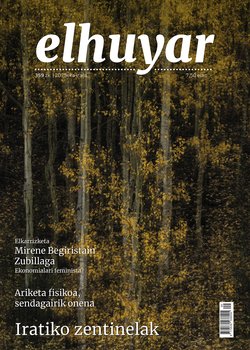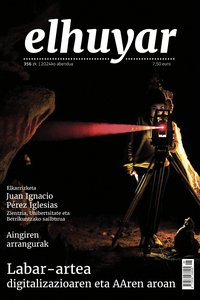Ready to eat for two months
Pre-cooked meals are increasingly seen on supermarket shelves: the pace and style of life we lead often motivates us to buy this type of food. And, once purchased, we ask that these meals be fresh and of quality, and that, starting to be requested, their expiration date is long. The company Xardexka of Oiartzun, aware of these needs, has put itself at the forefront of
the work and has devised a solution that we can already take to the mouth.
A product cooked, packaged and refrigerated at about 6 degrees Celsius will last between 7 and 15 days in edible form.
However, it appears that the durability of these products can be significantly increased. This is exactly what the Xardexka company has been doing over the last few months. The object of the invention
is to extend the expiration date of the food as much as possible, always without losing the quality of the cooked products. They have already managed to extend their duration for 2 months without the use of preservatives and additives in about 50 dishes.
Their daily battle is antibacterial, as the food is spoiled by bacteria.
AURORA BÁRCENA; QUALITY CONTROL IN XARDEXKA: It is about knowing the life span of the bacteria, how they function and the characteristics they need to reproduce; we want to interrupt the pathways through which the Bacteroides
reproduce. We need to deprive them of the temperature, food and water they like, and set high temperatures that they will not tolerate. By all these means, we will stop their growth.
Know the useful life of the bacteria, how they function, how they multiply, and take care of all these points in which we know that the bacteria are able to develop.
We have the temperature that you like, we have the food that you eat, we have the water that you drink, we have the heat that you give so strong that you don’t support it. All these mechanics are the ones who go to make their cremation. But by
what process do they manage to eliminate enough bacteria so that the food lasts two months?
The key lies in the drastic temperature changes they impose
on food. The process, however, begins in the kitchen, where the food has always been cooked; however, doing the cleaning with special care and at a specific ambient temperature.
SEBAS ESKAMENDI; CHEF OF XARDEXKA: Let's do the baker research now. Baker to pil-pil. Cook at 80°C for 1 minute. After processing in this autoclave the baker will be made
at 30%. Unlike any restaurant, the dishes in Xardexka leave the kitchen completely unfinished.In fact, in order to kill a large amount of bacteria, the food will undergo drastic temperature changes during the process. In order for the food to be properly cooked at the end of this path, they do not have to cook the dish completely in the kitchen.
Once the food has been packaged, the dish will be sealed by heat. They will remove all the oxygen, so they will kill the bacteria that need oxygen to live. The
next challenge is to eliminate bacteria that do not need oxygen to live. To do this, they will heat the food above 65 degrees during the pasteurization
process. SEBAS ESKAMENDI; THE CHEF OF XARDEXKA we will put the food at 80°C. Why 80°C? According to the tests carried out, the ray loses all the bacteria at this temperature.
AURORA BÁRCENA; QUALITY CONTROL IN XARDEXKA: If I put the food at 65, it'll take 20 seconds. if I set it to 75, it'll take 15 seconds, and if I set it to 80, three seconds will be enough. In this way, the product will deteriorate as little as possible.
If I pongo 65°C equal 20”. Si pongo 75 necesito 15”, si pongo 80, necesito 3”. I'm going down. I want to keep the maximum temperature for the weather to be longer
and for me to take less of the product.
The key to the invention is to place the product at the highest possible temperature without spoiling it. For each dish, it is necessary to search for the exact temperatures and times that correspond.
AURORA BÁRCENA; QUALITY CONTROL IN XARDEXKA: Food, both meat and fish, each has its own bacteria and microflora, and each develops at various levels of temperature and humidity. For this reason, each food requires its own precise temperature treatment.
Each time if it is clinical, if it is pessary, it usually has a bacterium, a different microflora that has a temperature and humidity condition. (...) Each one goes to have different temperatures of treatment.
If a food is heated to 120°C for 20 minutes, we can say that it is sterilized. As they approach this temperature during the pasteurization process, they will kill more and more bacteria and the product will have a longer shelf life.
AURORA BÁRCENA; QUALITY CONTROL IN XARDEXKA: With sterilization we can obtain a product that can remain in good condition for 5 years, that does not need cold and that we can collect in the home food warehouse. It can last almost as long as you want. But by exposing ourselves to these temperatures, our products do not maintain their quality, they dissolve.
With the sterilization that we follow a product that can last us 5 years, that we can have in the depths of the house that we do not need cold and that almost has an eternal life, but it is so that the temperature is so high that the product leaves us.
However, the cooked cod will undergo another drastic change. In a special refrigerator, the temperature will be reduced from 80 degrees to 5 degrees in half an hour. In this way, the bacteria that have managed to overcome the pasteurization will not be able to move due to the cold.
From this point on, it is essential to keep the cold chain at 4°C so that the meals maintain the two-month duration obtained through the process. When two months have passed to verify that
the cooked dish is in good condition to eat, it will be tested in the laboratory.
AURORA BÁRCENA; QUALITY CONTROL IN XARDEXKA: We offer the bacteria the right conditions they need to reproduce. We give them heat, because the bacteria need a warm environment; we give them food, even moisture.
What we do is to bring about the desired conditions for which it is possible to develop, the dams calor by which bacteria are interested in a calurous environment, the dams comida, the dams humedad. The bacteria will undergo the reverse process in the laboratory, i.e. they can represent what will happen when the consumer takes the food out of the refrigerator.
AURORA BÁRCENA; QUALITY CONTROL IN XARDEXKA: We have at hand samples of cod prepared in Xardexka. We have completed the whole process and kept the samples at the required temperature. If there were bacteria, we'd see them now with our own eyes, we wouldn't need the microscope.
Now we have the results of the samples that we have betrayed from the bacalao to the pil-pil of Xardexka. Then all of the process we've been talking about has been done, and then it's been incubated and, after incubation, if we've had bacterial strains we're going to see something, and we're not missing any microscopes or nothing. This would be what the sample would look like if the food needed it but had more bacteria. With the results in their hands, the product will be marketed in
a
refrigerated truck. Xardexka already has another dish on the market, but still has many more to investigate.
Buletina
Bidali zure helbide elektronikoa eta jaso asteroko buletina zure sarrera-ontzian











